Yoshi’s Cookie
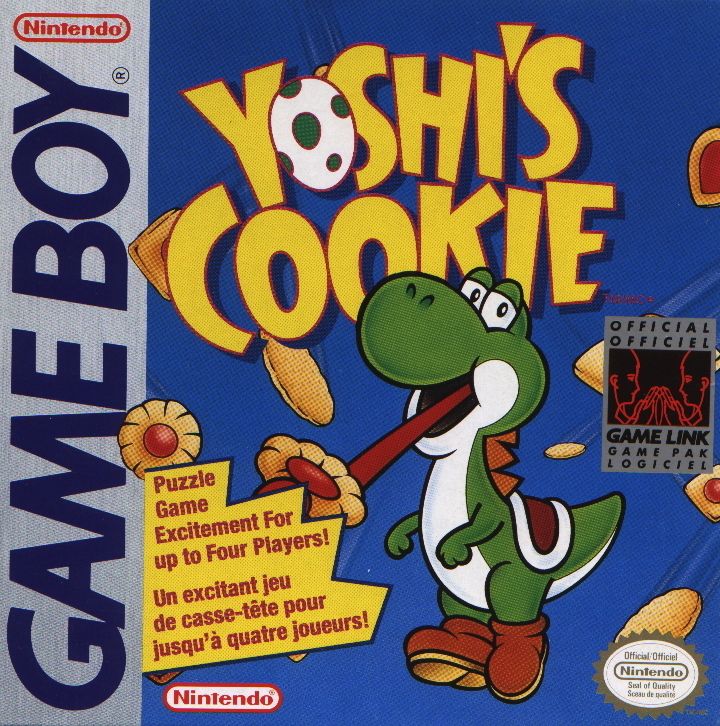
- Japanese release in November 1992
- North American release in April 1993
- European release in 1993
- Japanese release in March 2000
- Developed by TOSE
Play Around With Your Cookies

Yoshi’s Cookie is an unimpressive game with a beautiful premise. You start the game, you play one of its two simple modes and you realize it’s just a fine game about baking cookies. These days, a puzzle game with so few features would be derided. But it was good enough to warrant a small portion of your essential attention back in 1992 because of its creative design.
How Do You Play Yoshi’s Cookie?
Let’s discuss how Yoshi’s Cookie functions. You are presented with a board filled with cookies. You have a cursor that allows you to select a specific cookie. Pressing the X button then allows you to move rows and columns along the axis of that cookie. Cookies going past the other cookies will move to the other side of the board, keeping your playfield shaped like a rectangle at all times. While you move your field, new cookies start appearing from the top and right side of the board, slowly moving to align themselves with your batch of cookies. Using your single ability, you have to do the classic puzzle game task: match the objects. You make rows or columns of your playfields’ length, which then makes the matched cookies disappear.
I have nothing against the game, but it falls into the category of puzzle games I lovingly call I can’t get good at this shit. I am incapable of making high-level plays that allow you to get better at the game. You can arrange cookies in rows and columns to make them disappear. You’ll succeed for a bit but the real high-level play, the real talent you need to develop to succeed is to arrange the board so multiple rows and columns get completed at the exact same moment. To achieve this, you have to arrange the board with the maximum number of pieces that can be next to one another without creating a match. You need to do that for multiple rows and/or columns and you need to figure out a way to start those matches with a single move. It’s very similar in logic to learning how to solve a Rubik’s cube. You have to plan multiple moves ahead of time.
Multiple puzzle games have this prepared combo as their core premise. For example, Puyo Puyo, Columns, and to a lesser extent Dr. Mario all expect you to prepare combos. My problem is I’m horrible at preparing combos. I can get kind of bad at it but it’s hard for me, so a game really has to ease me into the combo-making steps. If you can show me how to make combos, with predefined puzzles that force you into the steps necessary to achieve it, I might be able to learn it before I get bored and give up with the game.
Another way for me to learn is by having an AI opponent make combos. That way I can see high-level play used against me and learn from it. This game being on Game Boy with its tiny screen, the VS mode does not show you your adversary’s moves. You can’t see their tactics and learn from them. With all those little issues piling up, Yoshi’s Cookie was unable to hold my attention long enough to force me to learn how to make its combos.
So while I’m not particularly enamoured by Yoshi’s Cookie as a game, I do love its development history.
From Home Data to Bullet-Proof Software to Nintendo to TOSE to Your Game Boy
How was Yoshi’s Cookie created? On the heels of Tetris being the flagship title for Game Boy, many developers were now making and selling puzzle games on Game Boy. Players were invariably looking for something like Tetris but different enough to give them a new experience. It was assuredly a profitable venture for those companies, but the games never accounted for more than 30% of yearly releases on the console. This low number of puzzle titles is in part due to how difficult it is to develop one. It takes a lot of time and creative thinking to invent a puzzle concept. This constant stream of puzzle releases was nonetheless a differentiating advantage of Game Boy in the early ’90s; the Sega Game Gear and Atari Lynx only offered their players a pitiful selection of puzzle titles and they never had Tetris. Henk Rogers snagged a portable console exclusivity agreement from Elorg for Nintendo. Henk Rogers once again pops up, and he is not only responsible for Tetris on Game Boy, but also responsible for Yoshi’s Cookie.
Ever the dealmaker, Henk Rogers finds a puzzle game called Hermetica developed by Home Data, a small Japanese company. The creator of the original game has talked about the development history on Twitter, and a translation by GDRI is available on the talk page for Biox of all places. They created the concept of the game as a way to do something with the old unused arcade boards the company had. The game had zero connection with Nintendo or Yoshi at that point. It was merely the work of a small Japanese company. The game used an alchemy conceit and a slightly different rule set. They finished development and moved on to a test release in two arcade locations in Japan. This test was very unsatisfactory. The people at the company then started shopping the game around to other companies in the hope they would license it. Henk Rogers was sent a prototype arcade board and saw enough potential to license the concept.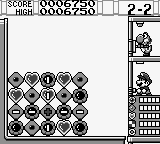
He afterwards commissions the employees at his company to work on their own version seemingly called Inaro. We’re not sure on how and when but Henk Rogers managed to convince Nintendo to join the project. They provided their greatest asset; the game was rebranded with their hottest new character, Yoshi. TOSE was at some point commissioned with the production of the NES and Game Boy version of what was now called Yoshi’s Cookie and Bullet-Proof Software made and finally released the SNES version eight months after the NES and Game Boy versions. Super Mario Wiki covers the development history very well and has links to fascinating details regarding Inaro.
The mystery of Yoshi’s Cookie strange release still lingers in my mind. You have two versions made by TOSE, the GB and NES versions. Those versions are for all intent and purposes the same and you have a very different SNES version that came out eight months later made by BPS. What’s even weirder is that the NES and Game Boy versions reference Hermetica in their debug menu.
If I had to hazard a guess, I’d say BPS was working on their own version for Super Famicom, under the codename Hermetica. When Nintendo came along and joined the project, they let BPS continue with the Super Nintendo/Super Famicom version and they took care of the Game Boy and NES/Famicom games. Nintendo then used TOSE as a subcontractor. They often used the company back then for lesser projects. A brand new puzzle game they didn’t fully own was a perfect use of TOSE, the shadow company who refuses to be credited for their work. TOSE quickly pumped out their two versions while BPS took more time, being a much smaller company. They also took the opportunity to implement more features. During this development, the codename of Hermetica was probably kept even after Yoshi’s Cookie became the game’s conceit later during development. Yoshi was an obvious choice for the game; it was a hot new character and Nintendo had already released a puzzle game bearing the name the year before. This could be seen as a kind of sequel. In terms of what’s different between the TOSE games and the BPS version for SNES, we have to talk about the last good Russian, Alexei Pajitnov.
Alexei Pajitnov’s Role
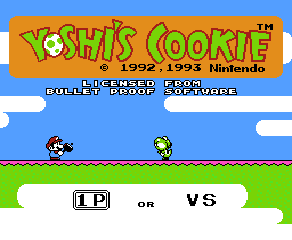
Pajitnov is credited on the box of the SNES version as a puzzle designer. I think he was a subcontractor, and honestly I’m a bit shocked he wasn’t on the marketing for the game. Keep in mind, dear reader, that he made puzzles for the SNES and SNES version only. He is not credited on Game Boy, and his creative puzzles are nowhere to be seen. I’m inclined to think Pajitnov worked on the game before the Yoshi branding was even decided. I get that putting his name on the box might have been confusing. You have decided on focusing the game on Yoshi and Mario, so Pajitnov only confuses things. But they totally could have had the puzzle section called Pajitnov’s Challenges or something. You mention it on the back of the box. In the game you put a little chibi version of Pajitnov just like Will Wright in Sim City. You have him say something along the lines of: “I invented Tetris you know! Can you solve my cookie puzzles? They’re devious, and delicious!”
That would have been cool. Especially since the Pajitnov puzzles of the SNES version are easily the best thing about any version of Yoshi’s Cookie. I heartily recommend giving them a try. It really shows that a great puzzle maker made them. In the end, I’m not Henk Rogers and I don’t know what was reasonable to do with Pajitnov’s likeness. Rogers and Pajitnov were, and are, friends and started The Tetris Company just a couple of years later. Maybe Pajitnov wasn’t interested in that kind of fame?
Conclusion
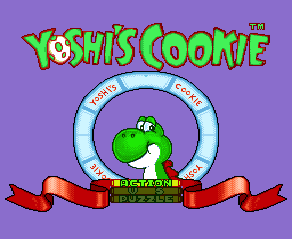
I’ve previously mentioned my hatred for the 1991 game Yoshi. Not Yoshi’s Cookie, just Yoshi. Another puzzle title featuring everybody’s favourite ridable dinosaur, Yoshi was a paper-thin excuse for a puzzle game that revealed its shallowness after mere minutes of play. Once you had hatched your first Yoshi with wings after a couple of minutes, you had seen everything the game had to offer. It was a sad game. Game Freak, the crew of people ultimately responsible for Pokémon made Yoshi. I think this proves my point that puzzle games are hard to make. Though the people at Game Freak were young and inexperienced, they had raw talent and great ideas. They were unable to make a good puzzle game and resorted to a very derivative concept.
Fortunately, Yoshi’s Cookie is neither shallow nor poorly made. It came a year later and was a sort of sequel to the earlier game, but it was developed by a completely different group of people. In contrast, Henk Rogers and the fine people at BPS knew how hard it was to come up with a good idea for a puzzle game. That’s why they licensed the original arcade concept. That’s why Nintendo collaborated with BPS; they knew good puzzle concepts are few and far between.
Ultimately, TOSE only needed to implement the puzzle concept for Game Boy and Famicom. The hardest part, coming up with the idea, was already licensed and adapted by the most successful company in the puzzle games market. It’s just a shame I’m so bad at preparing combos and can’t fully enjoy the game.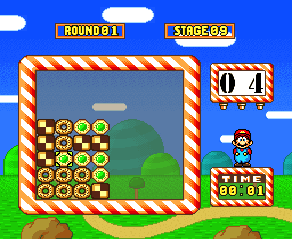 Boo-urns!
Boo-urns!
This article was first published on the .
This article was last modified on the .